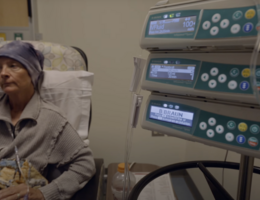
Dr. Hamid Mirshahidi says we can change the trajectory of lung cancer for future generations with education and early detection.
Lung cancer has long been linked to smoking, but doctors are now seeing more young adults diagnosed, including people who have never smoked.
Hamid Mirshahidi, MD, head of hematology/oncology division at Loma Linda University Cancer Center explains what is causing this change and why paying attention to symptoms matters.
A changing risk profile
More young non-smokers are getting lung cancer today. Some reasons include breathing polluted air, radon in homes, and secondhand smoke. But Mirshahidi says biology also plays a big role.
“Some individuals carry inherited traits that make their lung cells more vulnerable to mutations,” he explains. “This includes people with a family history of lung cancer, those with DNA-repair variations, and certain groups, such as East Asian women, who show higher rates of specific mutations.”
Doctors have also discovered something called driver mutations, changes in a cell’s DNA that make it grow too fast and turn into cancer. “These mutations act like an internal ‘on switch,’ allowing cancer to grow even without tobacco,” Mirshahidi says.
Myths and assumptions
Many people still believe lung cancer only happens to smokers, but that is not true.
“Up to 20% of lung cancers occur in people who have never smoked,” Mirshahidi says. “And roughly one in 10 cases are diagnosed in adults under 55.”
Vaping is also not harmless. Early research shows it can cause inflammation and lung damage over time.
The most harmful belief, Mirshahidi says, is the stigma that lung cancer patients caused their own disease. “The stigma is incredibly damaging. It discourages people from seeking care and creates unnecessary shame,” he says. “Anyone with lungs can get lung cancer.”
Screening guidelines
Current U.S. lung cancer screening rules focus on people with long smoking histories, but new research shows others may need screening too.
A large study from Taiwan looked at people who never smoked but had a family history. It found that over 90% of lung cancers were found at the earliest and most treatable stage.
“This study is reshaping global thinking about who should be screened,” Mirshahidi says. “It highlights how critical early detection is outside of traditional smoking-based criteria.”
Symptoms not to ignore
Young people may overlook warning signs because they think they are not at risk. Mirshahidi says anyone, smoker or not, should get checked if they have symptoms that last more than a few weeks.
Symptoms include:
- A cough that won’t go away
- Coughing up blood
- Trouble breathing
- Chest pain
- Feeling very tired or losing weight without trying
- Frequent lung infections
Treating lung cancer
The past decade has brought dramatic improvements in treatment options, many of which depend on comprehensive molecular testing.
“Molecular testing is absolutely essential,” Mirhsahidi says. “Without next-generation sequencing, many patients miss out on the most effective, personalized options available today.”
For patients without targetable mutations, chemo-immunotherapy combinations remain a standard and effective option.
Mirshahidi also looks forward to emerging treatments such as theranostics, a new approach that helps doctors detect and treat cancer using the same target in the body. It is already used for prostate cancer, and researchers are now studying it for lung cancer.
Clinical trials are underway, and experts believe theranostics may offer more precise and personalized lung cancer care in the future. These studies aim to improve precision, reduce toxicity, and offer treatments to patients who have exhausted standard options.
What younger adults can do now
Mirshahidi’s message is clear. Anyone with lungs can get lung cancer, and earlier detection saves lives.
To reduce risk and catch problems early, he recommends:
- Avoid smoking and vaping
- Test your home for radon, a harmful gas
- Limit exposure to air pollution and work hazards
- Know your family history
- Take symptoms seriously
- Ask your doctor if low-dose CT screening is right for you
“Education and early detection are our most powerful tools,” Mirshahidi says. “With ongoing research and awareness, we can change the trajectory of lung cancer for future generations.”
If you have symptoms that worry you, or if you want to learn more about your lung cancer risk, talk with your doctor or schedule a visit at Loma Linda University Cancer Center. Early testing and simple conversations can make a big difference.

